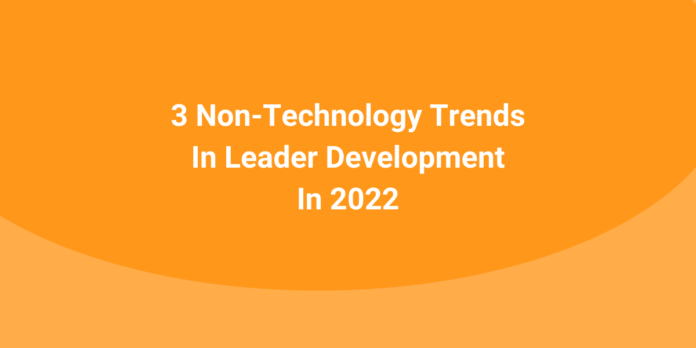
The year 2022 will be a defining moment for a lot of leaders, as many teams finally transition from “surviving” to “thriving.” After a turbulent start to the decade, we can once again set our sights on what we all ultimately want: to have the freedom to be the best version of ourselves; do work that is personally fulfilling and meaningful; to achieve our goals, and to grow in the process.
As the third wave of the pandemic subsides and physical safety becomes less of a concern, leadership development professionals must focus on helping employees ascend to reach their full potential through three areas: mental and psychological safety; belonging; and esteem.
Reducing fear and supporting employee mental health
The world is stressed. Some mental health experts have even gone as far as calling the recent rise in depression and anxiety the “second pandemic.” And it’s not going away anytime soon.
As such, leaders will have decisions to make in 2022 about how they will support employee mental health and eliminate fear at work. According to Nick Congelosi, manager of management and leadership development at HubSpot, failing to do so can have dire business consequences—beyond losing high performers.
“Fear destroys trust and innovation,” said Congelosi. “If you want to win in tomorrow's market, you need to mitigate fear today. Leaders should take care to not make work the most anxiety-producing activity in an already overly anxious world.”
Mitigating fear can take many forms. Some companies are now including mental health services in employee benefits packages. Others are embracing the 4-day work week in an effort to curb work-related burnout. At the very least, Congelosi advises leaders to work at increasing psychological safety in 2022.
And to increase psychological safety, leaders will need to take the first step in being vulnerable. “In a fast-moving and uncertain business environment, the most innovative leaders are those who are the most vulnerable,” said disruption strategist and keynote speaker Shawn Kanungo. “We often demand our leaders to have all the right answers, but today it requires humility. The world is moving too fast to keep up—we don’t need leaders to be all-knowing heroes, we need leaders that have the courage to say: ‘help me.’”
Add Belonging to DEI
Diversity, equity, and inclusion gained “belonging” as a counterpart in 2021, but in 2022, creating belonging will be a central leadership theme. Author, speaker, and positive psychology researcher Tamara Myles says belonging is the emotional aspect of diversity and inclusion: inclusion is an action, and belonging is how we feel when we are included. There are plenty of companies in which surface-level diversity and inclusion efforts have no real impact on whether or not people feel they belong.
“The Venn Diagram of leadership skills and DEIB is a circle,” continued Congelosi. “You can't be a great leader and not be an inclusive leader who is championing Diversity. We're only getting started on DEIB in the workplace, realistically. If you are not looking at DEIB from everything from culture to compensation and actively mitigating bias, you are not setting your organization up for success in the future. DEIB is not an add-on, it's a critical ingredient to any business strategy.”
As such, leaders will need to focus on developing DEIB leadership skills, viewing them as crucial leadership competencies rather than programs. Myles calls on three A’s to help leaders think about belonging: alignment, appreciation, and amity.
“Values alignment is crucial for belonging, as is alignment with the organization’s ‘why,’” explained Myles. “When we are together working towards something that's bigger than ourselves, it can create a strong sense of belonging. Appreciation speaks to our desire to feel like a valued member of the community—and not just for our contributions, but for who we are as unique individuals. Finally, amity is another word for friendship. We find in our research that the organizations that have the highest sense of belonging are the ones in which leaders are intentional about strengthening social bonds within teams and across the whole organization.
Esteem Needs: Fully Embracing the Total (and Changing) Person
Before we can reach the summit of Maslow’s pyramid, we must first do the difficult and important work of making peace with our true selves—and then have the courage and confidence to bring that self to work. Many organizations heralded as best places to work have earned their accolades because they embrace the employee as a whole person. But who we are isn’t fixed; we grow and change over time. As such, as leaders do their own work to be authentic, they must perfect the difficult dance of accepting employees as they are today while challenging them to a higher, better version of that authentic self.
“Who we are changes over time, so what is authentic for us evolves,” said Sally Helgesen, author of How Women Rise, and a Top 50 Thinker winner. “Overvaluing authenticity can be an excuse for bad behaviors (‘I just gotta be me!’) or quite simply for not growing up.”
The leaders who will bring out the best in their people in 2022 are those who can manage this tension—holding employees accountable for their behavior while giving them the freedom to explore and refine their interests. This requires—in contrast to popular opinion—holding onto employees loosely. The best leaders want the best for their people—even if that means cheering for their success in another role or another company. People change, as do their passions, desires, opinions, and motivations. The organizations that will ultimately succeed are those that give people room—and permission—to change.







